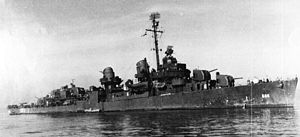- USS Newcomb (DD-586)
-

Career (US) 
Namesake: Frank H. Newcomb Builder: Boston Navy Yard Laid down: 19 March 1943 Launched: 4 July 1943 Commissioned: 10 November 1943 Decommissioned: 20 November 1945 Struck: 28 March 1946 Fate: Scrapped, October 1947 General characteristics Class and type: Fletcher class destroyer Displacement: 2,050 tons Length: 376 ft 6 in (114.7 m) Beam: 39 ft 8 in (12.1 m) Draft: 17 ft 9 in (5.4 m) Propulsion: 60,000 shp (45 MW); 2 propellers Speed: 35 knots (65 km/h) Range: 6500 nmi. (12,000 km) @ 15 kt Complement: 329 Armament: 5 × 5 in./38 guns (127 mm),
4 × 40 mm AA guns,
4 × 20 mm AA guns,
10 × 21 in. torpedo tubes,
6 × depth charge projectors,
2 × depth charge tracksUSS Newcomb (DD-586) was a Fletcher-class destroyer in the United States Navy during World War II. She was the only ship named for Commodore Frank H. Newcomb of the United States Revenue Cutter Service, Congressional Gold Medal recipient from the Spanish-American War.
Newcomb was laid down 19 March 1943 by Boston Navy Yard; launched 4 July 1943, sponsored by Mrs. C. C. Baughman; and commissioned 10 November 1943, Commander L. B. Cook in command.
Contents
History
Newcomb shook down in the West Indies for a month, then made passage to the Marshall Islands, arriving 4 April 1944 for two months duty on antisubmarine patrol off the Japanese held Mille, Wotje, and Jaluit atolls. She next joined the assault on Saipan as flagship for the screen from 29 May until 5 August, serving as fire support and patrol ship at both Saipan and Tinian. On 22 June, while guarding transports, she and Chandler (DMS-9) sank Japanese submarine banzai attack north of Garapan on Saipan.
Operating in the Fire Support and Bombardment Group for the assault on the Palaus 6 September to 1 October, Newcomb fired 23 separate shore bombardments and also covered underwater demolition teams providing bombardment control spotting. As flagship of Destroyer Squadron 56 (DesRon 56), Newcomb joined in the Leyte landings 12 October to 4 December, covering underwater demolition teams and firing preinvasion-bombardment, call-fire, night-harassing and illumination missions.
Her squadron made a night torpedo attack in the Surigao Strait phase of the Battle for Leyte Gulf 25 October. At least one of her 5 torpedoes struck battleship Yamashiro, sunk in this action. Closely straddled but not damaged, Newcomb went to the aid of stricken Albert W. Grant (DD-649), providing medical aid and a tow out of the battle area. In this classic sea battle, Newcomb and her sisters played a key role in the great American victory which insured the success of General Douglas MacArthur's return to the Philippines, and effectively ended major Japanese naval threats for the remainder of the war.
Often under fire from Japanese aircraft, several of which she destroyed, Newcomb continued service in the Philippines, engaging Japanese shore batteries at Ormoc 9 December while screening landing craft, fighting a convoy through heavy enemy air attack to Mindoro 19 through 24 December, and driving off 2 would-be kamikazes during the Lingayen landing 6 January 1945. She covered operations in Lingayen Gulf through 24 January, then prepared for duty as fire support ship at Iwo Jima from 10 February, where she covered minesweeping for three days prior to the landing. During the invasion the destroyer engaged shore batteries and fired pinpoint-accurate bombardments of inestimable assistance to troops ashore. She again engaged a Japanese submarine 25 February, with unknown results.
Departing Iwo Jima 10 March, Newcomb joined the Okinawa assault force 11 days later, and again covered underwater demolition and minesweeping operations as well as antiaircraft and shore bombardment until 6 April, when she was screening minesweepers off Ie Shima. At least 40 enemy aircraft were observed in the area during the day, and at 16:00 suicide attacks began. Though handicapped by a low ceiling, her gunners were able to drive off or shoot down several attackers, but over a period of an hour and a half, she was struck five times. With a skill and fighting spirit which won them a Navy Unit Commendation, her crew worked furiously to repair engine damage and extinguish fires, while continuing to fight their ship and maneuver to avoid further crashes. Aid was rendered by Leutze (DD-481), herself struck by the fifth kamikaze skipping across from Newcomb, and Beale (DD-471). Indomitably afloat, fires and power out, with 18 killed, 25 missing, and 64 wounded, Newcomb was towed to Kerama Retto by Tekesta (ATF-93).
Repairs to her hull were made by Vestal (AR-4) under frequent enemy air attack, and 14 June she left under tow for Saipan, Pearl Harbor, and San Francisco, arriving 8 August.
Fate
The end of the war ended further repairs, and Newcomb decommissioned 20 November 1945. Stricken from the Navy List 28 March 1946, she was scrapped at Mare Island Navy Yard in October 1947.
Newcomb received 8 battle stars for World War II service.
See also
References
- This article includes text from the public domain Dictionary of American Naval Fighting Ships. The entry can be found here.
External links
- USS Newcomb website at Destroyer History Foundation
- Navsource.Org: DD-586 Newcomb
- Forward Repair following Kamikaze strikes, April 1945
Categories:- World War II destroyers of the United States
- Ships built in Massachusetts
- 1943 ships
- Fletcher class destroyers of the United States Navy
- Ships damaged by kamikaze attack
Wikimedia Foundation. 2010.
